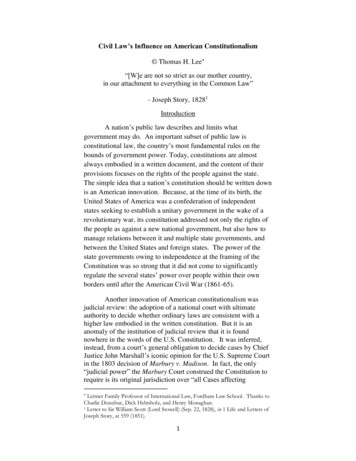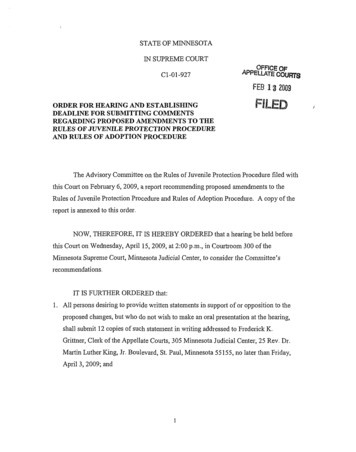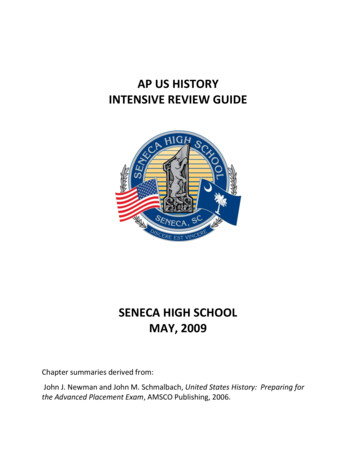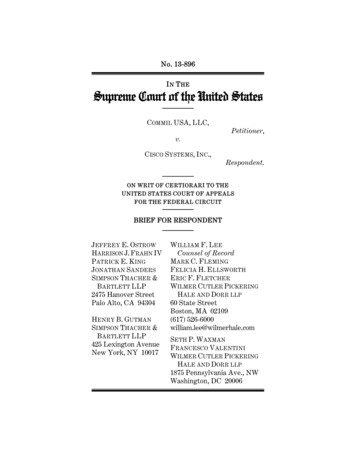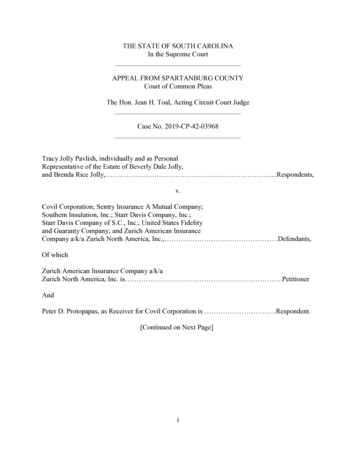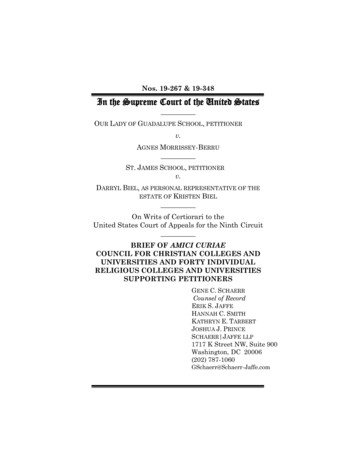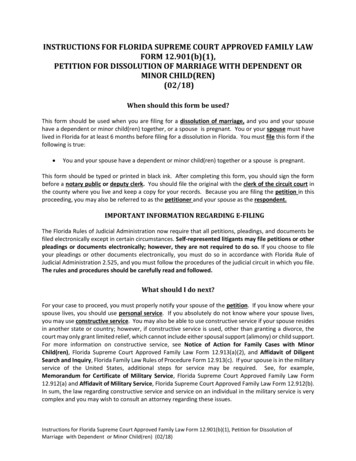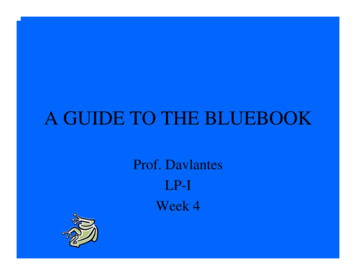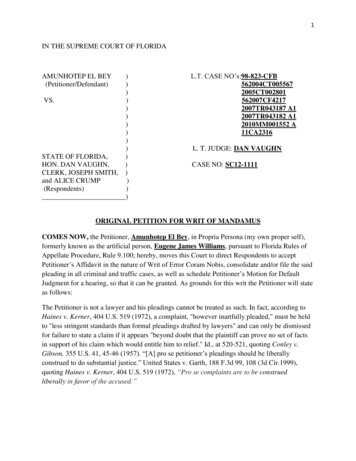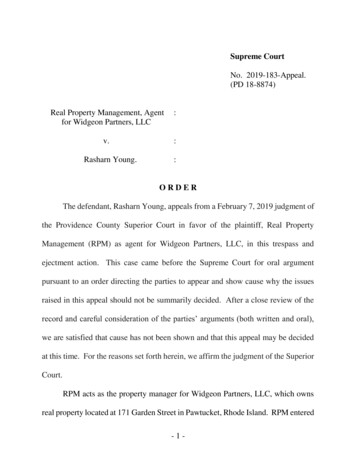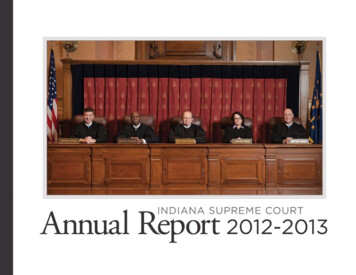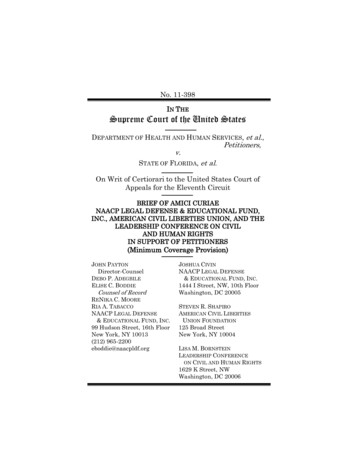
Transcription
No. 11-398IN THESupreme Court of the United StatesDEPARTMENT OF HEALTH AND HUMAN SERVICES, et al.,Petitioners,v.STATE OF FLORIDA, et al.On Writ of Certiorari to the United States Court ofAppeals for the Eleventh CircuitBRIEF OF AMICI CURIAENAACP LEGAL DEFENSE & EDUCATIONAL FUND,INC., AMERICAN CIVIL LIBERTIES UNION, AND THELEADERSHIP CONFERENCE ON CIVILAND HUMAN RIGHTSIN SUPPORT OF PETITIONERS(Minimum Coverage Provision)JOHN PAYTONDirector-CounselDEBO P. ADEGBILEELISE C. BODDIECounsel of RecordRENIKA C. MOORERIA A. TABACCONAACP LEGAL DEFENSE& EDUCATIONAL FUND, INC.99 Hudson Street, 16th FloorNew York, NY 10013(212) 965-2200eboddie@naacpldf.orgJOSHUA CIVINNAACP LEGAL DEFENSE& EDUCATIONAL FUND, INC.1444 I Street, NW, 10th FloorWashington, DC 20005STEVEN R. SHAPIROAMERICAN CIVIL LIBERTIESUNION FOUNDATION125 Broad StreetNew York, NY 10004LISA M. BORNSTEINLEADERSHIP CONFERENCEON CIVIL AND HUMAN RIGHTS1629 K Street, NWWashington, DC 20006
iTABLE OF CONTENTSTABLE OF CONTENTS . iTABLE OF AUTHORITIES . iiiINTERESTS OF AMICI . 1SUMMARY OF THE ARGUMENT. 3ARGUMENT . 5I. The minimum coverage provision enhancesthe ability of individuals to participate inthe economic, social, and civic life of our nation, thereby advancing equal opportunityand personal liberty. 5A.The uninsured are more likely toexperience conditions that inhibit thequality of life. . 6B.The minimum coverage provisionpromotes equal opportunity. . 9C. The ability to self-insure is not analogous to any liberty interests recognized by this Court . 121.The provision imposes minimalburdens on liberty. 142.Under the Court’s CommerceClause jurisprudence, individualsmust sometimes yield economicliberty to advance the collectivegood. . 16II. The Necessary and Proper Clause furthersupports the constitutionality of theminimum coverage provision. 21
iiCONCLUSION. 24
iiiTABLE OF AUTHORITIESCasesBond v. United States, 131 S. Ct. 2355 (2011) . 13Bryan v. Koch, 627 F.2d 612 (2d Cir. 1980) . 1Cruzan v. Director, Missouri Department ofHealth, 497 U.S. 261 (1990) . 14-15Delaware v. Prouse, 440 U.S. 648 (1979) . 15-16Employment Division v. Smith, 494 U.S. 872(1990) . 20Garcia v. Vanguard Car Rental USA, Inc., 540F.3d 1242 (11th Cir. 2008) . 16Gonzales v. Raich, 545 U.S. 1 (2005). 18-19, 22Griswold v. Connecticut, 381 U.S. 479 (1965). 15Heart of Atlanta Motel, Inc. v. United States,379 U.S. 241 (1964) . 11Hosanna-Tabor Evangelical Lutheran Church& School v. EEOC, No. 10-553, 556 U.S.(2012) . 20Jacobson v. Massachusetts, 197 U.S. 11 (1905) . 15Katzenbach v. McClung, 379 U.S. 294 (1964) . 11Lawrence v. Texas, 539 U.S. 558 (2003) . 11, 15Linton v. Commissioner of Health &Environment, 65 F.3d 508 (6th Cir. 1995). 1Lochner v. New York, 198 U.S. 45 (1905). 13McCulloch v. Maryland, 4 Wheat. 316 (1819) . 21Moore v. City of East Cleveland, 431 U.S. 494(1977) . 15
ivMussington v. St. Luke’s-Roosevelt HospitalCenter, 824 F. Supp. 427 (S.D.N.Y. 1993) . 1NLRB v. Jones & Laughlin Steel Corp., 301U.S. 1 (1937) . 14, 19Ophthalmic Mutual Insurance Co. v. Musser,143 F.3d 1062 (7th Cir. 1998) . 16Parents Involved in Community Schools v.Seattle School District No. 1, 551 U.S. 701(2007) . 11PlannedParenthoodofSoutheasternPennsylvania v. Casey, 505 U.S. 833 (1992). 15Rackley v. Board of Trustees of OrangeburgRegional Hospital, 238 F. Supp. 512(E.D.S.C. 1965) . 1Rochin v. California, 342 U.S. 165 (1952). 15Sabri v. United States, 541 U.S. 600 (2004). 23Seven-Sky v. Holder, 661 F.3d 1 (D.C. Cir.2011). 22Simkins v. Moses H. Cone Memorial Hospital,323 F.2d 959 (4th Cir. 1963) . 1Thomas More Law Center v. Obama, 651 F.3d529 (6th Cir. 2011). 16, 18United States v. Comstock, 130 S. Ct. 1949(2010) . 21, 23-24United States v. Darby, 312 U.S. 100 (1941). 19United States v. Lee, 455 U.S. 252 (1982) . 19-20United States v. Lopez, 514 U.S. 549 (1995) . 23United States v. Wrightwood Dairy Co., 315
vU.S. 110 (1942) . 23Washington v. Glucksberg, 521 U.S. 702(1997) . 14-15West Coast Hotel Co. v. Parrish, 300 U.S. 379(1937) . 13-14Wickard v. Filburn, 317 U.S. 111 (1942). 16-19Federal StatutesHealth Care and Education Reconciliation Actof 2010, Pub. L. No. 111-152, 124 Stat. 1029(2010) . 3Patient Protection and Affordable Care Act,Pub. L. No. 111-148, 124 Stat. 119 (2010). 326 U.S.C. § 5000A . 426 U.S.C. § 5000A(f)(1) . 1442 U.S.C. § 300gg . 2142 U.S.C. § 300gg-1 . 942 U.S.C. § 300gg-1(a). 2142 U.S.C. § 300gg-3(a). 2142 U.S.C. § 18091(a)(2)(A) . 442 U.S.C. § 18091(a)(2)(E) . 842 U.S.C. § 18091(a)(2)(F) . 8-9, 2242 U.S.C. § 18091(a)(2)(G) . 742 U.S.C. § 18091(a)(2)(I) . 9, 22
viCourt FilingsConsent Decree, Terry v. Methodist Hospitalof Gary, Nos. H-76-373, H-77-154 (N.D. Ind.June 8, 1979) . 1Other AuthoritiesJames A. Baker III Institute for Public Policyof Rice University, The Economic Impact ofUninsured Children on America (Houston,Tex.), June 2009. . 7-8Robin A. Cohen et al., Health Insurance Coverage: Early Release of Estimates from theNational Health Interview Survey, 2010(National Center for Health Statistics),June 2011. 7Jack Hadley, Sicker and Poorer: The Consequences of Being Uninsured (Kaiser FamilyFoundation, Wash., D.C.), May 10, 2002. 7Catherine Hoffman & Julia Paradise, HealthInsurance and Access to Health in theUnited States, 1136 Annals N.Y. Acad. Sci.149 (2008) . 8Institute of Medicine, Committee on the Consequences of Uninsurance, Coverage Matters: Insurance and Health Care (2001). 10-11Institute of Medicine, Committee on the Consequences of Uninsurance, Health Insurance Is a Family Matter (2002) . 6-8Kaiser Commission on Medicaid and the Uninsured, The Uninsured: A Primer, KeyFacts About Americans Without Health In-
viisurance (Kaiser Family Foundation, Wash.,D.C.), Oct. 2007. 6-7, 10Neil S. Siegel, Four Constitutional Limits thatthe Minimum Coverage Provision Respects,27 Const. Comment. 591 (2011) . 4Kristen Suthers, Evaluating the EconomicCauses and Consequences of Racial andEthnic Health Disparities (American PublicHealth Association, Wash., D.C.), Nov.2008. 8, 10U.N. Committee on the Elimination of RacialDiscrimination, Consideration of ReportsSubmitted by States Parties under Article 9of the Convention, Concluding Observations of the Committee on the Eliminationof Racial Discrimination, United States ofAmerica (May 2, 2008), available 61.pdf (last visited Jan. 10, 2012). 10
1INTERESTS OF AMICI 1The NAACP Legal Defense & Educational Fund,Inc. (LDF) is a non-profit legal organization that formore than seven decades has helped African Americans secure their civil and constitutional rights.Throughout its history, LDF has worked to supportand provide equal treatment and high-quality medical services, care, and opportunities to AfricanAmericans. E.g., Linton v. Comm’r of Health &Env’t, 65 F.3d 508 (6th Cir. 1995) (preservation ofMedicaid-certified hospital and nursing home beds toprevent eviction of patients in favor of admittingmore remunerative private-pay individuals); Bryanv. Koch, 627 F.2d 612 (2d Cir. 1980) (challenge toclosure of municipal hospital serving inner-city residents); Simkins v. Moses H. Cone Mem’l Hosp., 323F.2d 959 (4th Cir. 1963) (admission of AfricanAmerican physician to hospital staff); Mussington v.St. Luke’s-Roosevelt Hosp. Ctr., 824 F. Supp. 427(S.D.N.Y. 1993) (relocation of services from innercity branch of merged hospital entity); Rackley v. Bd.of Trs. of Orangeburg Reg’l Hosp., 238 F. Supp. 512(E.D.S.C. 1965) (desegregation of hospital wards);Consent Decree, Terry v. Methodist Hosp. of Gary,Nos. H-76-373, H-77-154 (N.D. Ind. June 8, 1979)(planned relocation of urban hospital services frominner-city community). LDF has a substantial inter1 Pursuant to Supreme Court Rule 37.6, counsel for amicistate that no counsel for a party authored this brief in whole orin part, and that no person other than amici, their members, ortheir counsel made a monetary contribution to the preparationor submission of this brief. The parties have filed blanket consent letters with the Clerk of the Court pursuant to SupremeCourt Rule 37.3.
2est in this case because of its continuing commitment to promoting opportunity for African Americans, including access to affordable health insuranceand health care.The American Civil Liberties Union (ACLU) is anationwide, nonpartisan, nonprofit organizationwith more than 500,000 members dedicated to theprinciples of liberty and equality embodied in theConstitution and this nation’s civil rights laws.Since it was founded in 1920, the ACLU hasappeared before this Court in numerous cases, bothas direct counsel and as amicus curiae. The ACLUhas a substantial interest in the proper resolution ofthis case because of its potential impact on the ability of millions of uninsured Americans to participatemore fully in the economic, political, and social life ofthe Nation.The Leadership Conference on Civil and HumanRights is a diverse coalition of more than 200national organizations charged with promoting andprotecting the rights of all persons in the UnitedStates. The Leadership Conference was founded in1950 by A. Philip Randolph, head of the Brotherhoodof Sleeping Car Porters; Roy Wilkins of the NAACP;and Arnold Aronson, a leader of the National JewishCommunity Relations Advisory Council. The Leadership Conference works to build an America that isas good as its ideals, and toward this end, supportsthe authority of Congress to enact legislation, suchas the Patient Protection and Affordable Care Act,which provides for the general welfare of the nation.Access to quality health care is a fundamental civiland human right, but the current system of healthcare in the United States denies this right to the
3most vulnerable segments of society, including lowincome families, people of color, women, seniors, andpeople with disabilities. By addressing the huge disparities in both access to and quality of care, thePatient Protection and Affordable Care Act takes amomentous step toward ensuring that all Americanscan benefit from affordable, high-quality health care.SUMMARY OF THE ARGUMENTIn our modern, integrated, and dynamic healthcare system, personal choices have consequencesthat extend far beyond the individual. The economicdecision to forego health insurance, therefore, is notneutral. Rather, such a decision, when aggregatedacross our national population, both limits the personal liberty of others to choose health insuranceand has the effect of reinforcing harsh economic andsocial disparities that threaten our country’s democratic foundation and the cohesion of our society.The minimum essential coverage provision of thePatient Protection and Affordable Care Act (“ACA”or “the Affordable Care Act”), Pub. L. No. 111-148,124 Stat. 119 (2010), 2 promotes opportunity for millions of uninsured persons to participate in the life ofour nation. It achieves this objective by makinghealth insurance and, ultimately, health care itselfmore affordable. This, in turn, alleviates the severefinancial burdens that fall on the uninsured, whichhave a disproportionate negative impact on disadvantaged populations. By reducing the exclusionary,harmful effects of the current system, the minimum2 As amended by the Health Care and Education Reconciliation Act of 2010, Pub. L. No. 111-152, 124 Stat. 1029(2010).
4coverage provision, 26 U.S.C. § 5000A – the cornerstone of ACA – enables covered persons to leadhealthier, freer, and more productive lives, therebyadvancing the twin goals of liberty and equal opportunity. Respondents, therefore, go too far in suggesting that the provision trenches on individual libertyin ways that require this Court to curtail federalpower.Amici support the position of the United Statesthat the Eleventh Circuit erred in its analysis ofCongress’s power to enact the minimum coverageprovision under both the Commerce and Necessaryand Proper Clauses. Pet. Br. 17-20. Congress actedwell within its constitutional authority in seeking toregulate “‘economic and financial decisions abouthow and when health care is paid for, and whenhealth insurance is purchased” 3 in order to preventthe severe economic and social upheaval that occurswhen significant portions of the national populationare uninsured. 4 See 42 U.S.C. § 18091(a)(2)(A).Amici write separately to address the EleventhCircuit’s mischaracterization of the liberty intereststhat are at stake in this case and to emphasize thepositive role the minimum coverage provision playsin advancing equal opportunity. Amici additionallydemonstrate that the Necessary and Proper ClauseSee Neil S. Siegel, Four Constitutional Limits that theMinimum Coverage Provision Respects, 27 Const. Comment.591, 596-99 (2011) (describing economic nature of decision toself-insure).34 In 2009, the number of uninsured persons totaled approximately 50 million. Pet. Br. 7.
5supports Congress’s authority to enact the minimumcoverage provision.ARGUMENTI. The minimum coverage provision enhancesthe ability of individuals to participate inthe economic, social, and civic life of ournation, thereby advancing equal opportunity and personal liberty.Across our country, uninsured persons experiencesignificant hardship that has a profound cumulativeimpact on our nation. Because they are less likely toobtain adequate, stable health care, the uninsuredsuffer many lost opportunities, which depresses boththe quality and the longevity of their lives. Theseburdens are disproportionately borne by racial andethnic minorities, lower-income persons, and otherdisadvantaged persons. For many individuals, beinguninsured is not a choice, but rather is a consequencethat is imposed on them due to circumstanceslargely beyond their control. See Pet. Br. 6 (“Thecoverage gaps [the uninsured] experience result forthe most part from the high cost of insurance andemployment changes – not a belief that coverage isunnecessary.”).Yet, although they lack steady access to healthcare, uninsured persons are not completely precluded from using medical services. Id. at 7. Unforeseen crises can lead to costly emergency roomvisits and hospitalizations that, while not covered bythe uninsured, are still paid for by the health caresystem as a whole, eventually leading to higherinsurance premiums for everyone. Id. at 7-8. By requiring non-exempt individuals to bear some of the
6cost of their otherwise uncompensated 5 care, theminimum coverage provision has the effect of lowering the cost of health insurance and making healthcare more affordable and accessible. It is an essential component of the Affordable Care Act’s comprehensive regulatory framework, id. at 24-32, thatultimately helps to protect and to improve the livesof uninsured persons and to reduce the severe inequities of our current system.A. The uninsured are more likely to experience conditions that inhibit the qualityof life.From cradle to grave, lack of insurance can (andoften does) result in life-inhibiting and personallycatastrophic conditions that threaten the very core ofa person’s ability to function. Because of the highcost of health care under our current system, the uninsured must often choose between paying directlyfor health care services and other, basic life necessities. Kaiser Comm’n on Medicaid and the Uninsured, The Uninsured: A Primer, Key Facts AboutAmericans Without Health Insurance (hereinafterPrimer on Uninsured) (Kaiser Family Found.,Wash., D.C.), Oct. 2007, at 9. Faced with these difficult tradeoffs, the uninsured are far more likely toaccumulate significant debt and to experience thelife-altering effects of severe financial hardship. SeeInst. of Med., Comm. on the Consequences of Uninsurance, Health Insurance Is a Family Matter (hereinafter Family Matter) 77 (2002). Those who cannot5 “Uncompensated care” refers to “care received by uninsured patients but not paid for by them or by a third party ontheir behalf.” Pet. Br. 8.
7endure the financial burdens of non-covered healthcare services may simply decide to forego them.It is unsurprising, therefore, that the uninsuredhave higher rates of illness, see Primer on Uninsuredat 7-8, and suffer the effects of lost educational, employment, and other social and civic opportunities.Over time, this lost human capital degrades theirlives and isolates them from the rest of the population. As multiple studies show, those without insurance often lead chaotic lives. They are less likely toreceive preventative care for treatable illnesses,resulting in serious and even life-threatening conditions. See Family Matter at 87-88; Jack Hadley,Sicker and Poorer: The Consequences of Being Uninsured (hereinafter Sicker and Poorer) (Kaiser FamilyFound., Wash., D.C.), May 10, 2002, at 5-9. Childrenwith untreated health problems are less likely to attend and to perform well in school. Family Matter at122-24; Sicker and Poorer at 15. Being uninsuredalso correlates with other poor educational outcomes,such as failing to graduate from high school or toenroll in college. See Robin A. Cohen et al., HealthInsurance Coverage: Early Release of Estimates fromthe National Health Interview Survey, 2010 (hereinafter Health Insurance Coverage) (Nat’l Ctr. forHealth Statistics), June 2011, at 4; Primer on Uninsured at 5. The uninsured often amass significantdebt as a result of unforeseen medical expenses,leading to a downward, destabilizing financial spiral,including poor credit, Primer on Uninsured at 9;bankruptcy, 42 U.S.C. § 18091(a)(2)(G); lost wages;lower annual earnings, Sicker and Poorer at 13-14;and unemployment, James A. B
Medicaid-certified hospital and nursing home beds to prevent eviction of patients in favor of admitting more remunerative private-pay individuals); Bryan v. Koch, 627 F.2d 612 (2d Cir. 1980) (challenge to closure of municipal hospital serving inner-ci

